Los Millares – 5,000-Year-Old Advanced Copper City In Europe
A. Sutherland - AncientPages.com - About 5,000 years ago, Los Millares was Europe's biggest and most important town. The ruins of the city of Los Millares are situated on a plateau at an altitude of 270 meters - a perfectly chosen strategic location near Almeria, on the southern coast of Spain.
 Credit: Museo Arqueológico Nacional de España
Credit: Museo Arqueológico Nacional de España
Los Millares' people possessed highly developed technical knowledge and introduced copper metallurgy in the Western Mediterranean Sea. They also grew farming and built a vast cemetery for collective burials.
Inhabited by approximately 1,000 people at the time of maximum splendor, the city had an extensive and complex defensive system of defensive solid walls and forts with several outposts for protection.
The site's history is not yet precisely known, but historians are sure it was abandoned about 250 years after the pyramids were built in ancient Egypt.
After many years of plunder and neglect, the city's historical importance was finally recognized thanks to the first excavation made in 1891 by two Belgian mining engineers, Luis Siret, and his brother. They became intrigued by the city's archaeological remains.
 Remains of tomb. Credits: Museo Arqueológico Nacional de España
Remains of tomb. Credits: Museo Arqueológico Nacional de España
The sparsely excavated archaeological site revealed many circular huts with a diameter of 4 to 7 meters, stone plinths, earthen floors made of rammed earth, and stone mills.
Finally, the city looked like a fortified fortress with four lines of thick walls of six-meter (20 ft). The last one was 310 meters long and 4 meters high and punctuated at intervals of twelve to fifteen meters, with a sophisticated gateway, a series of towers and 15 bunkers for outer defense, and a water cistern.
Several simple dwellings lay inside the citadel, as well as a complex structure with traces of smelting and a hall-like rectangular stone building that was probably used for inhabitants' meetings, ceremonies, and other entertainment.
 The history of the site is not yet exactly known but is known that it was abandoned about 250 years after the pyramids were built in ancient Egypt. Illustration of the village of Los Millares, the first city on the Iberian Peninsula. / IÑAKI DIEGUEZ URIBE.
The history of the site is not yet exactly known but is known that it was abandoned about 250 years after the pyramids were built in ancient Egypt. Illustration of the village of Los Millares, the first city on the Iberian Peninsula. / IÑAKI DIEGUEZ URIBE.
The discovered necropolis ('city of the dead') consists of a collective burial mound and about 100 'tholos tombs' - beehive tombs.
Similar structures have been discovered in Turkey and Greece and built with stone roofs forming a dome. An interior system comprises an atrium or hall, a corridor separated by slabs, and a circular perforated chamber about four meters in diameter lined with a slate plinth.
 5,000 year old pottery shards have been found scattered across the site.Credits: Museo Arqueológico Nacional de España
5,000 year old pottery shards have been found scattered across the site.Credits: Museo Arqueológico Nacional de España
The graves were decorated with symbolic ceramic objects, metal weapons, richly decorated ivory items, and many idols.
In excavations of some circular cabins close to the town's defensive walls, archaeologists unearthed numerous household objects such as plates, dishes, pots, traces of cheese making, arrows, and handmade clay objects.
 During excavations of some circular cabins located close to the defensive walls of the town, archaeologists unearthed numerous household objects such as plates, dishes, pots, traces of cheese making, arrows, and handmade clay objects. Credits: Museo Arqueológico Nacional de España; Arte Historia
During excavations of some circular cabins located close to the defensive walls of the town, archaeologists unearthed numerous household objects such as plates, dishes, pots, traces of cheese making, arrows, and handmade clay objects. Credits: Museo Arqueológico Nacional de España; Arte Historia
Many unanswered questions remain regarding this most unique and mysterious city of Neolithic Europe.
How did they obtain advanced metal smelting techniques? How did the metal culture of Los Milllares evolve? What kind of danger did the inhabitants face? Was the harassment of the city's population related to the possession of copper mines and the existence of metallurgy highly developed copper?
Recent carbon testing showed that the Los Millares existed much earlier than previously thought, so the appearance of metallurgy in this area would have a local explanation by the existence and development of a previous culture (Culture of Almería), 3,000 years BC.
Written by A. Sutherland – AncientPages.com Staff Writer
Updated on September 19, 2022
Copyright © AncientPages.com All rights reserved. This material may not be published, broadcast, rewritten or redistributed in whole or part without the express written permission of AncientPages.com
Expand for referencesReferences:
G. A. Jimenez, S. Montón Subías, The Archaeology of Bronze Age Iberia: Argaric Societies
More From Ancient Pages
-
 Who Were The Sin Eaters?
Ancient History Facts | Jan 21, 2020
Who Were The Sin Eaters?
Ancient History Facts | Jan 21, 2020 -
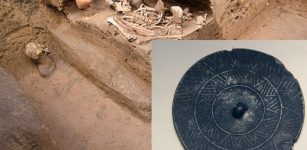 Qijia Culture – Its Disappearance Remains An Ancient Mystery
Civilizations | Feb 5, 2021
Qijia Culture – Its Disappearance Remains An Ancient Mystery
Civilizations | Feb 5, 2021 -
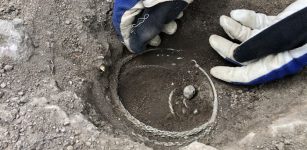 Wonderful And Unique Viking Silver Treasure Uncovered In Täby In Stockholm, Sweden
Archaeology | Nov 29, 2022
Wonderful And Unique Viking Silver Treasure Uncovered In Täby In Stockholm, Sweden
Archaeology | Nov 29, 2022 -
 Are We Really In A Sixth Mass Extinction?
News | Apr 11, 2023
Are We Really In A Sixth Mass Extinction?
News | Apr 11, 2023 -
 New Project Aims To Solve Mysterious Millennia-Old Rock Carvings Of Argyll, Scotland
Archaeology | Mar 20, 2017
New Project Aims To Solve Mysterious Millennia-Old Rock Carvings Of Argyll, Scotland
Archaeology | Mar 20, 2017 -
 Unusual 7,000-Year-Old Jar Decorated With A Horned Face Found In Poland
Archaeology | Sep 3, 2020
Unusual 7,000-Year-Old Jar Decorated With A Horned Face Found In Poland
Archaeology | Sep 3, 2020 -
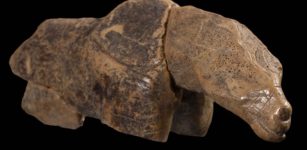 Curious Ice Age Figurine Of Unidentified Animal Species Puzzles Scientists
Archaeology | Jul 31, 2023
Curious Ice Age Figurine Of Unidentified Animal Species Puzzles Scientists
Archaeology | Jul 31, 2023 -
 Unusual Biblical Cloud – What Was This Perplexing Atmospheric Phenomenon?
Ancient Mysteries | Feb 22, 2019
Unusual Biblical Cloud – What Was This Perplexing Atmospheric Phenomenon?
Ancient Mysteries | Feb 22, 2019 -
 Mystery Of The Black Irish People: Who Were They?
Civilizations | May 24, 2016
Mystery Of The Black Irish People: Who Were They?
Civilizations | May 24, 2016 -
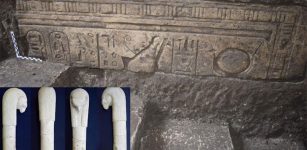 Ancient Tools Used In Religious Rituals In Honor Of Goddess Hathor Discovered In Egypt
Archaeology | Sep 27, 2021
Ancient Tools Used In Religious Rituals In Honor Of Goddess Hathor Discovered In Egypt
Archaeology | Sep 27, 2021 -
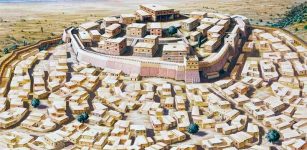 Ancient City Of Troy Was Destroyed By An Earthquake That Ended The Trojan War – Archaeologists Say
Archaeology | Jun 14, 2017
Ancient City Of Troy Was Destroyed By An Earthquake That Ended The Trojan War – Archaeologists Say
Archaeology | Jun 14, 2017 -
 Abundantia: Roman Goddess Who Was Shaking Her Gifts From Cornucopia – ‘Horn Of Plenty’
Featured Stories | Nov 4, 2019
Abundantia: Roman Goddess Who Was Shaking Her Gifts From Cornucopia – ‘Horn Of Plenty’
Featured Stories | Nov 4, 2019 -
 How Ancient Cultures Explained Comets And Meteors
Archaeoastronomy | Jun 5, 2019
How Ancient Cultures Explained Comets And Meteors
Archaeoastronomy | Jun 5, 2019 -
 Unknown Sketch Of Jesus Christ By Leonardo Da Vinci Could Be The Holy Grail Of Art
News | Nov 24, 2020
Unknown Sketch Of Jesus Christ By Leonardo Da Vinci Could Be The Holy Grail Of Art
News | Nov 24, 2020 -
 Dice Existed Long Before Recorded History And Were Not Always Perfect Cubes
Archaeology | Feb 1, 2018
Dice Existed Long Before Recorded History And Were Not Always Perfect Cubes
Archaeology | Feb 1, 2018 -
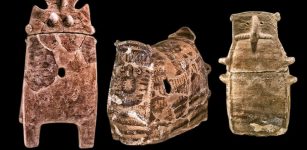 Blue Eyed People In Northern Israel 6,500 Years Ago: New DNA Results
Archaeology | Aug 22, 2018
Blue Eyed People In Northern Israel 6,500 Years Ago: New DNA Results
Archaeology | Aug 22, 2018 -
 Mystery Of Moses’ Double Mask, Dramatic Personality Change And The Hidden Prophet – What Did Really Happen On Mount Sinai?
Ancient Mysteries | Jun 25, 2018
Mystery Of Moses’ Double Mask, Dramatic Personality Change And The Hidden Prophet – What Did Really Happen On Mount Sinai?
Ancient Mysteries | Jun 25, 2018 -
 John Hawkwood ‘John Sharp’: Feared, English Mercenary And His White Company In 14th Century Italy
Featured Stories | Jun 20, 2020
John Hawkwood ‘John Sharp’: Feared, English Mercenary And His White Company In 14th Century Italy
Featured Stories | Jun 20, 2020 -
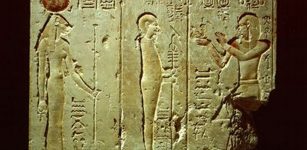 Egyptian Temple Culture In Ptolemaic-Era Survived Changes And Became Even Stronger – Researcher Says
Archaeology | Mar 1, 2017
Egyptian Temple Culture In Ptolemaic-Era Survived Changes And Became Even Stronger – Researcher Says
Archaeology | Mar 1, 2017 -
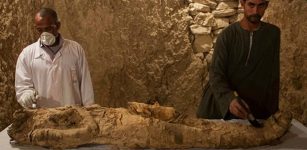 Mummy Of Unidentified Official Discovered In 3,500-Year-Old Tomb In Luxor, Egypt
Archaeology | Dec 11, 2017
Mummy Of Unidentified Official Discovered In 3,500-Year-Old Tomb In Luxor, Egypt
Archaeology | Dec 11, 2017

